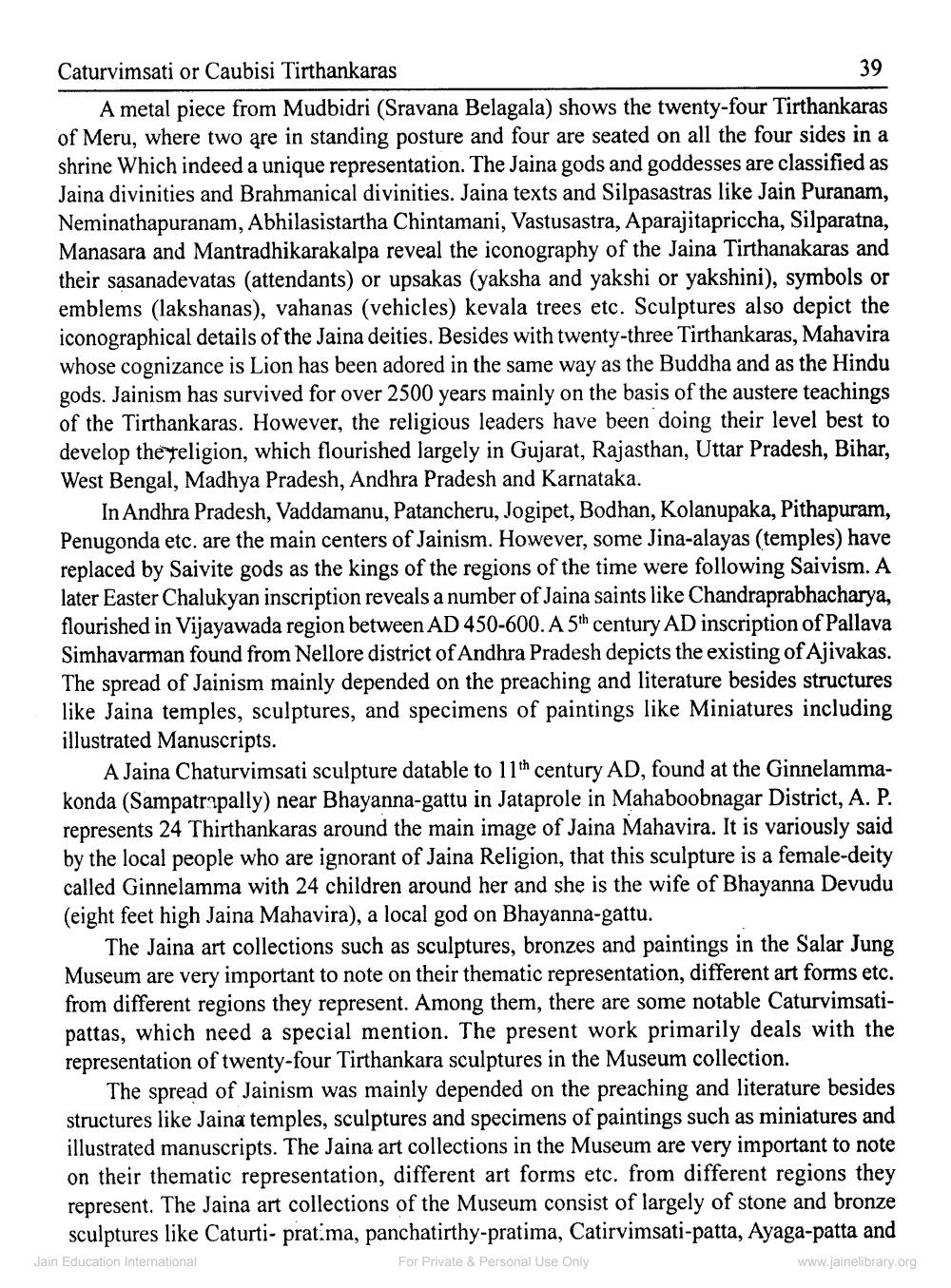________________
Caturvimsati or Caubisi Tirthankaras
39 A metal piece from Mudbidri (Sravana Belagala) shows the twenty-four Tirthankaras of Meru, where two are in standing posture and four are seated on all the four sides in a shrine Which indeed a unique representation. The Jaina gods and goddesses are classified as Jaina divinities and Brahmanical divinities. Jaina texts and Silpasastras like Jain Puranam, Neminathapuranam, Abhilasistartha Chintamani, Vastusastra, Aparajitapriccha, Silparatna, Manasara and Mantradhikarakalpa reveal the iconography of the Jaina Tirthanakaras and their sasanadevatas (attendants) or upsakas (yaksha and yakshi or yakshini), symbols or emblems (lakshanas), vahanas (vehicles) kevala trees etc. Sculptures also depict the iconographical details of the Jaina deities. Besides with twenty-three Tirthankaras, Mahavira whose cognizance is Lion has been adored in the same way as the Buddha and as the Hindu gods. Jainism has survived for over 2500 years mainly on the basis of the austere teachings of the Tirthankaras. However, the religious leaders have been doing their level best to develop the religion, which flourished largely in Gujarat, Rajasthan, Uttar Pradesh, Bihar, West Bengal, Madhya Pradesh, Andhra Pradesh and Karnataka.
In Andhra Pradesh, Vaddamanu, Patancheru, Jogipet, Bodhan, Kolanupaka, Pithapuram, Penugonda etc. are the main centers of Jainism. However, some Jina-alayas (temples) have replaced by Saivite gods as the kings of the regions of the time were following Saivism. A later Easter Chalukyan inscription reveals a number of Jaina saints like Chandraprabhacharya, flourished in Vijayawada region between AD 450-600. A 5th century AD inscription of Pallava Simhavarman found from Nellore district of Andhra Pradesh depicts the existing of Ajivakas. The spread of Jainism mainly depended on the preaching and literature besides structures like Jaina temples, sculptures, and specimens of paintings like Miniatures including illustrated Manuscripts.
A Jaina Chaturvimsati sculpture datable to 11th century AD, found at the Ginnelammakonda (Sampatrapally) near Bhayanna-gattu in Jataprole in Mahaboobnagar District, A. P. represents 24 Thirthankaras around the main image of Jaina Mahavira. It is variously said by the local people who are ignorant of Jaina Religion, that this sculpture is a female-deity called Ginnelamma with 24 children around her and she is the wife of Bhayanna Devudu (eight feet high Jaina Mahavira), a local god on Bhayanna-gattu.
The Jaina art collections such as sculptures, bronzes and paintings in the Salar Jung Museum are very important to note on their thematic representation, different art forms etc. from different regions they represent. Among them, there are some notable Caturvimsatipattas, which need a special mention. The present work primarily deals with the representation of twenty-four Tirthankara sculptures in the Museum collection.
The spread of Jainism was mainly depended on the preaching and literature besides structures like Jaina temples, sculptures and specimens of paintings such as miniatures and illustrated manuscripts. The Jaina art collections in the Museum are very important to note on their thematic representation, different art forms etc. from different regions they represent. The Jaina art collections of the Museum consist of largely of stone and bronze
sculptures like Caturti- pratima, panchatirthy-pratima, Catirvimsati-patta, Ayaga-patta and Jain Education International For Private & Personal Use Only
www.jainelibrary.org




